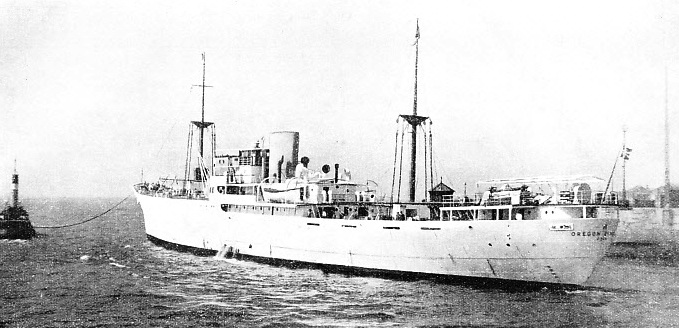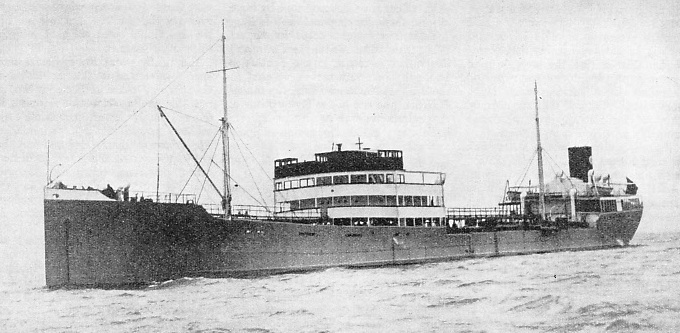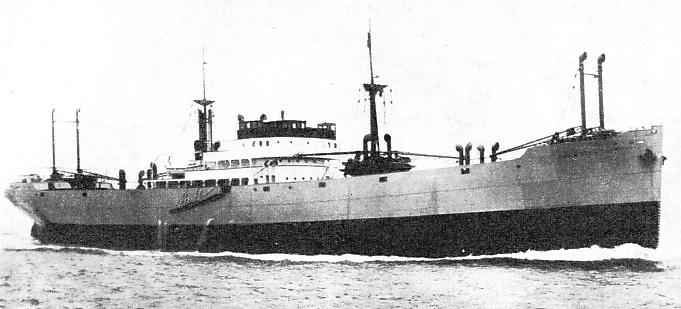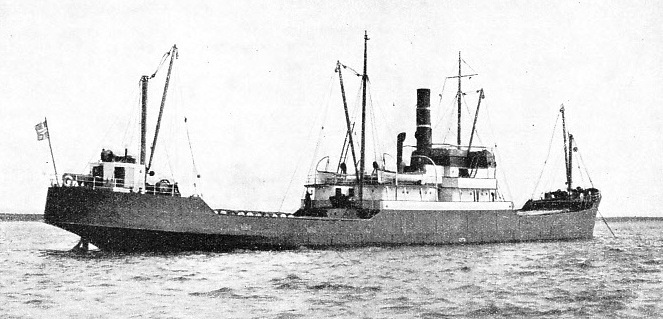

© Shipping Wonders of the World 2012-

Norwegian Shipping
A maritime nation such as Norway produces a fine type of sailor, and the descendants of the ancient Vikings run exceedingly efficient world-
SEA TRANSPORT OF THE NATIONS -

A MODERN MOTOR-
IN many ways the Norwegian Merchant Service is one of the most remarkable in the world, for it has changed out of all recognition since the war of 1914-
There has always been a strong link between Norwegian and British seamen and the submarine campaign stirred up the feeling of the modern Vikings more than anything else, and caused the greater part of the Norwegian Merchant Service to be placed at the disposal of Great Britain.
Its services in keeping the country fed were invaluable. They had to be paid for in hard cash, but the price that Norway herself had to pay was a heavy one. More than 1,000,000 tons gross of Norwegian shipping, nearly half of the total fleet, were sunk by enemy action, and 1,600 Norwegian seamen were killed or drowned. Despite the risk, the Norwegians took the same personal pride as the British in signing on the moment they landed from a torpedoed ship. They were not actuated by hope of gain alone, for they had deep feeling.
Their war losses started in August 1914, when the steamers Tysla and Gottfried were mined in the North Sea although they were taking no part in the war. A Norwegian ship, the tanker Belridge, was one of the first victims of the submarine war against commerce in February 1915. Norwegian shipping was made a particular mark of submarine attack in 1916-
Not only were the Norwegians able, as neutrals, to take full advantage of the steadily rising freight markets, but they also bought ships where they could, no matter what the price, and took any business opportunity which offered itself through the withdrawal of the combatant’s tonnage. A lot of this business was formerly German, and the Norwegians had to fight hard for it when the German Mercantile Marine was rebuilt after the war.
Many other neutral countries with merchant shipping at their disposal made big profits over the war, but not many nations contrived to use them with such good effect to build up a vast fleet. It was the wise handling of war profits, by the authorities and the individual, that made Norwegian shipping what it is.
Practically every Norwegian is more keenly interested in the sea and ships than in any other subject, so that he puts his savings into the shipping industry purely as an investment and without any thoughts of speculation. The prices of shares rise and fall, but not to the extent that they do in most other maritime countries. Gigantic shipping groups which become so overgrown that they are bound to collapse and ruin thousands of speculators are so far unknown. Early in the war the authorities looked years ahead and in co-
The building and acquisition of ships was encouraged only while the war was actually in progress. The moment peace was declared the far-
It is doubtful, however, whether the wisest of Governments or employers could have attained this result had it not been that the great bulk of the nation was essentially ship-
The Government never loses sight of the interests of the Mercantile Marine and has procured it many advantages in treaties with other countries. Although the taxation of the Mercantile Marine’s profit is the principal prop of the State’s existence, every care is taken not to kill the goose, and the subsidy system is definitely barred except in a few services where the circumstances are such that it is impossible to maintain a shipping service on its profits and impossible to maintain communications without it. The ancient Kingdom of Norway exists solely by its shipping and seamen, and no young Norwegian is ever allowed to forget that.
It is through this wise admimistration of resources and understanding of shipping as a whole that the Norwegian merchant fleet has its present position. Glancing through the tables of the world’s shipping without care it might appear that this position has not improved so much, for Norway was fourth on the list in 1914 and was fourth in 1936. The tonnage of her powered ships, however, has gone up from 1,957,353 to 3,967,000, and the fleet has so changed in character that the carrying capacity of this tonnage is infinitely greater.
Importance of Invisible Exports
Before 1914 a quarter of the fleet consisted of sailing vessels, the majority of them old and bought from the British flag. Now-
Only a small proportion of Norway’s ships are employed on Norway’s own trade, roughly ten per cent of them at the most, so that all the profits made by the industry are invisible exports of the country. The existence of the industry, and through it the prosperity of the greater part of the population, depend on the whole world being open to its services, so that subsidy policies or trade restrictions on the part of foreign countries are a severe handicap to Norwegian shipping. To get their business they must either cut their rates or offer better service with faster and more efficient ships. Before the war cut prices were their great strength and Norwegian tramps could accept low rates; but nowadays that policy is in disrepute and every effort is made to find the business by the quality of the service rendered.
It is a curious and in many ways unfortunate thing that in the tramp business quality counts for nothing – until it becomes so had that the underwriters step in. To change their policy, therefore, the Norwegians also had to change their fleet: from having the great majority on the tramping trade, picking up cargo where they could, they turned to cargo liners of infinitely better quality and speed, running on their regular schedule full or empty. Whether their owners were particularly wise in foreseeing the post-

A NORWEGIAN MOTOR TANKER, the Storaas was built in 1929 at Gothenburg, Sweden. She is a twin-
There was little regular cargo business in Norway before the war, although some of the charters were so regular that, they almost amounted to liner services. The carriage of fruit has interested Norway for half a century or more, originally perhaps on account of the fine seaman ship required by the flying schooners that made such wonderful passages for their size. That side is now covered by the Fruit Express Line from California, by a branch of Fred Olsen‘s big concern and by many other flourishing companies. The Bergenske Line, with its regular short-
An excellent example of the manner in which this tonnage has been improved is shown by Wilhelm Wilhelmsen, whose significent ships are known all over the Seven Seas. When, some years ago, he built a cargo vessel with a speed of 14 knots, he made a speech at her launch deploring the necessity of building such a fast and extravagant ship. He said he would never have done it if he had not been forced into it by foreign competition. His latest ships, diesel-
It was in 1914, when the majority of ships under the Norwegian flag were small tramps and the average size was only 1,700 tons deadweight, that their first sizeable motor ship was built. It was not until after the war that they had the opportunity of building the magnificent fast ships which form a large proportion of their fleet to-
In this decision they have been partly influenced by the social legislation in the country, for instance their manning and victualling scale, which makes the operation of small ships expensive under their flag. It is undoubtedly the prestige that these fine vessels have given to the whole Merchant Service that has prompted the Norwegians to go on improving; and to insist on the best that the builders, mostly outside Norway, can.
Principal Carriers of the World
In 1936 about half of the tonnage under the Norwegian flag was diesel driven, and although the Norwegians have to import all their oil fuel they have found the internal combustion engine admirably suited to their purpose and have been particularly successful in collecting a fine body of diesel engineers in Norway itself.
The question of imported fuel is of less importance to the Norwegians than it is to most of the maritime nations, because only a small proportion of Norway’s trade is concerned with the country itself. They are rapidly becoming the principal carriers of the world, rivalling the British for the position which the Dutch made for themselves in the seventeenth century. Many of the ships visit their home ports only for necessary repairs and recommissioning. A business of this sort makes the utmost economy essential. Neither the British nor the Dutch, who originally had the carrying trade practically to themselves, begrudge the Norwegians the share that they have secured, for they have always played the game with absolute fairness; and shipping men who are exceedingly enterprising themselves appreciate the enterprise that the Norwegians have shown. In the Far East, for instance, although the Norwegians are in competition with the State-

DIESEL-
This post-
Despite their magnificent fleet of cargo liners the Norwegians own few overseas passenger ships. Their biggest passenger liner is the Stavangerfjord, built in 1918, with a gross tonnage of 13,156, running between Norway and the United States and taking yachting cruises. A new fast motorship for this service was ordered from Germany in 1936.
Norway owns some noteworthy short-
There are also a large number of small passenger ships on the coast, where the sea route is the only practical one between many important points and where the Government has encouraged the maintenance of efficient steam services over since 1827, when it started operating two steamers on its own account. The total coasting fleet is only a small proportion, between three and four per cent, of the Merchant Service, and most of the individual ships are quite small. Many of them are remarkable little vessels in their way, designed for a special purpose and fulfilling their functions in all weathers.
Speculative Building Checked
About one-
A large number of these ships, however, are not purely Norwegian. Some years ago the American oil interests, finding it expensive to run their ships under the Stars and Stripes to the standards on which American law insisted, helped Norwegian owners to build a large number of tankers which were immediately taken up on time charter for a considerable number of years.
These ships were not allowed to ply between various points in American territory under their Coastal Reservation Law, but they could take American oil to any other country in the world and could be economically run. This policy caused an immense amount of speculative building, which the Government checked by passing a law that withheld Norwegian registration for ships of any owners whose paid-
Another important section of the Norwegian merchant service, again concerned principally with the goods of other countries, consists of the fast fruit carriers, mostly motor-
Despite all the fine ships which they have built of recent years, and the excellent manner in which they are maintained, the greatest asset of Norwegian shipping is still her seamen and is always likely to remain so. The natural conditions of Norway, and the traditions of the country, cause nine youngsters out of ten to regard the sea as the only ideal method of earning a living; hardy, skilful and cheerful, the modem Norwegian sailor is a worthy descendant of the ancient Viking.
The State recognizes the sailor’s value and for his benefit has passed many laws concerning manning, pay and victualling scales, comfortable accommodation and good working conditions. Now he comes to regard the ship as his home and signs on for long voyages quite happily. The Norwegian sailor is popular wherever he goes, which is a great asset in the carrying trade between foreign countries.

THE POSITIONS OF THE MASTS of the Atle Jarl are such as to permit the biggest possible amount of deck cargo to be carried. She is a timber carrier of 1,173 tons gross, built in 1919 at Fredrikstad Norway, and registered at Trondheim. The Atle Jarl is 230 ft 6 in long, with a beam of 36 ft 1 in and a depth of 14 ft 10 in.
You can read more on “Mariehamn’s Grain Fleet”, “Samsons of the Sea” and “The Svealand” on this website.